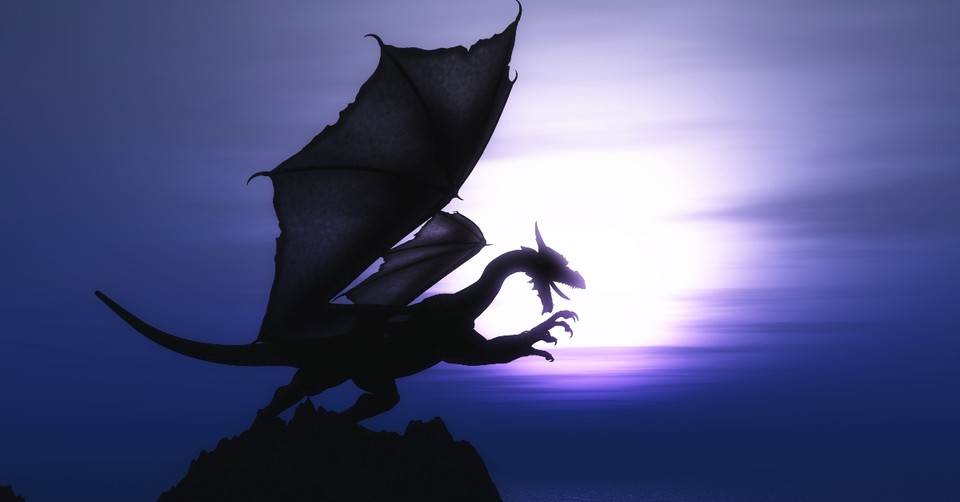Are There Dragons in the Bible?

Many people wonder if there are dragons in the Bible. We live in a time of fascination with all manner of fantastical creatures—both real and mythic. Ancient and modern literature from children’s stories to mythic legends to young adults’ books are rife with dragons, both terrifying and heroic. Are dragons mentioned in the Bible and if so, are we right to make friends with them, or are they always on the side of evil?
What Do Dragons Represent in the Bible?
The Bible refers to dragons using at least three terms. The first is tanniyn, which according to Strong’s Concordance, can be translated as dragon, serpent, or sea monster (#H8577). The modern usage of the term includes crocodile. It occurs some 28 times in the King James Version (for example, Exodus 7:9, Deuteronomy 32:33, Job 30:29, Psalm 74:13, or Isaiah 51:9). Later translations may translate the same word jackal, sea monster, or dragon depending on the context. Similar to it, and often cited, is livyathan (#H3867), or Leviathan, elaborated on at length in Job 41 but mentioned also in Psalm 104:26, and Isaiah 27:1. There is much conversation and debate about the specific translation of these words and whether they support the existence of dragons, dinosaurs, or sea monsters or are better translated by terms referring to other animals or beasts.
The more straightforward term is drakon (#G1404 in Strong’s concordance). Strong’s defines it as “a fabulous kind of serpent (perhaps as supposed to fascinate).” This word appears 13 times in the book of Revelation and is used to refer to Satan. This is a callback metaphor to Genesis 3:1 where the serpent approached Eve in the Garden of Eden.
Whenever we approach Scripture, context is key. Exodus 7:9 is a reference to Moses’ staff, which when it was cast down, became a serpent or snake. Exodus is a book of history and so we read this as the serpent in the context of the showdown between Pharaoh’s wise men and Moses.
Revelation is prophetic literature, so references to the serpent or dragon in this context should be understood through a metaphorical, prophetic lens. It’s clear from Revelation 12:9 that the writer of Revelation refers to Satan because he tells us that he does.
Job is considered wisdom literature. We understand Job to be a historical figure but there are poetic elements of the book, especially when God responds to Job. In Job 40 and 41, God mentions both Behemoth, a powerful grass-eating animal, and Leviathan, a monstrous sea creature with great scales who breathes fire. From a young earth worldview, these could be understood as land and sea dinosaurs, existing in tandem with humans. Another view could explain these as creatures whose size and ferocity were imposing to humans—such as a hippopotamus and a crocodile. This mention in Job 41:18-21 is what leads many readers to think the reference is to something more dragon-like than a crocodile: “His sneezings flash forth light, and his eyes are like the eyelids of the dawn. Out of his mouth go flaming torches; sparks of fire leap forth. Out of his nostrils comes forth smoke, as from a boiling pot and burning rushes. His breath kindles coals, and a flame comes forth from his mouth.”
Again, context is crucial when exploring all references. It would appear from Job 41 that God is describing a sea creature. This is reinforced in Psalm 104:26, ESV, “There go the ships, and Leviathan, which you formed to play in it.”
In Isaiah 27:1 ESV, however, there would appear to be more than one level of understanding to the prophet’s reference to Leviathan, “In that day the LORD with his hard and great and strong sword will punish Leviathan the fleeing serpent, Leviathan the twisting serpent, and he will slay the dragon that is in the sea.” This seems to reference a being beyond any crocodile, dragon, or sea creature.
Where Are Dragons in Apocryphal Literature?
There is a story in Apocryphal literature, included in Greek Septuagint, but not the Hebrew Bible about Daniel defeating Bel, the dragon. This story is included in Catholic Bibles which contain the Apocrypha but is not considered canonical. In this story, in order to convince those who worship Bel that God is mightier and deserving of worship over this dragon idol, Daniel defeats him with poison.
What Is the History of Dragons in the Church?
Dragons as mythical creatures appear throughout literary history. Prior to Christianity, they were viewed much as other creatures—sometimes predatory and treacherous, other times helpful or supportive of humans.
During the early church age and throughout Medieval times, dragons took on a more sinister meaning because, in the book of Revelation, they represent Satan. This has also led some Christians, in modern times, to eschew representing dragons as friendly beasts or as misunderstood. In their understanding, this may lead to a watering down of the danger of evil and the true risk Satan presents to humanity.
Other believers view dragons as created beings who can be depicted in a variety of ways. In their understanding, since the comparison is metaphorical, we don’t have to condemn all representations of dragons. They cite the example of lions. Lions are created beings which are used, at times, in the Bible to represent Jesus, such as in Revelation 5:5, while at another time, lions are used as a simile for Satan (1 Peter 5:8-9 ESV). While they agree the dragon of Revelation is Satan, they don’t believe it’s necessary to consider all depictions of dragons as representative of evil.
Dragons Around the World
In Egypt, the dragon was associated with crocodiles and symbolized rain, floods, and evil.
Some Native American cultures refer to the “thunder lizard” and have legends about the formation of the earth by a dragon and a great god. Likewise, in Vietnam and other countries, the dragon took part in creation.
Of course, the dragon is a powerful symbol in Chinese culture and is associated with the Emperor and the sky. Ancient Chinese believed the sky is divided into nine palaces, each ruled by a dragon. Dragons in China are associated with elemental power.
In modern Western culture, dragons continue to be depicted as fierce representatives of danger and evil, but they are also widely utilized in fantasy literature, films, and video games ranging from treasured pets to misunderstood beasts to powerful talismans.
How Should We Approach Dragons?
There’s no debate that dragons are a popular subject in our society and throughout history. Their mystery, power, and fire-breathing capacity make them an understandable draw for storytellers, artists, and moviemakers alike. The symbolism of dragons is fairly consistent across cultures and includes power, chaos, hidden knowledge, strength, and evil. They’re associated with great treasures that they hoard and protect. The danger and challenge of dragons inspire humans to imagine conquering them (St. George and the Dragon) or domesticating them.
Christians are wise to know what the Bible says and to read the account in Revelation about the battle against the dragon, which in Revelation is Satan and his final end. God chooses symbols and metaphors for a reason and we shouldn’t brush past them as if they were casual choices.
It’s also important to consider what dragons symbolize to others when they use them as either cultural representations, characters in stories or art, games, and merchandise. Some may choose them as simple literary devices while others may understand their association with Satan and have more sinister motives. Dragon symbols are rampant in our modern culture but not everyone is using them to represent evil.
Digging into all the references to dragons, Leviathan, Behemoth, and other creatures is an interesting study both because of the topic, but also for the discussion of translation and metaphor. Whether we encounter dragons in real life or in symbolism and metaphor, it’s always wise to approach them with caution and to be aware that their beauty and power may be masking greater malevolence than we initially imagine.
Photo credit: ©iStock/Getty Images Plus/kirstypargeter
Originally published January 27, 2021.






